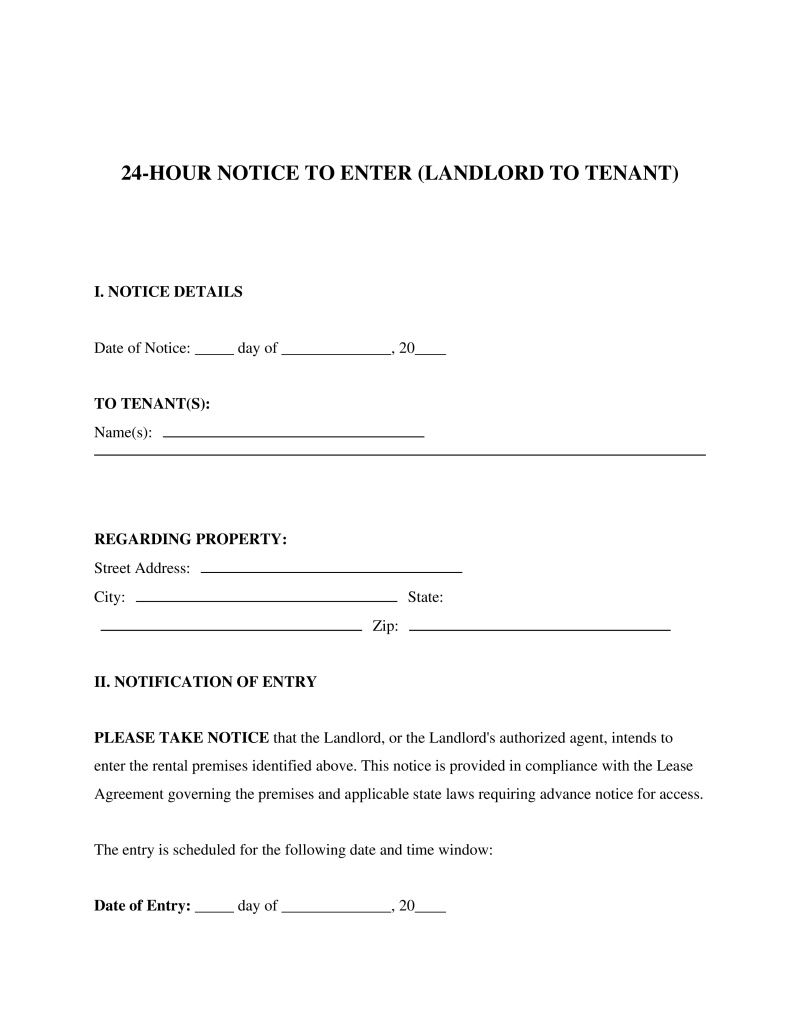A 24-Hour Notice to Enter is a legal notification by which landlords inform tenants of their intent to enter the premises.
Purpose
Select whether you are issuing this notice as an individual or as part of a business/property management company.

Table of Contents
What is a 24-Hour Notice to Enter (Landlord to Tenant)?
A 24-Hour Notice to Enter (Landlord to Tenant) is a legally binding document that landlords must provide to tenants before entering their rental property for reasons such as maintenance, inspection, or showing the property to potential buyers or renters. It serves to respect the tenant's privacy rights while ensuring the landlord can perform necessary duties related to property management and upkeep. This notice is crucial for landlords who need to access a property but want to do so in compliance with state laws and lease agreements, thereby avoiding potential legal issues and maintaining a positive relationship with their tenants.
Key Features
Important Provisions
- Notification Period: Specifies that notice must be given at least 24 hours in advance of entry.
- Entry Purpose: Clearly delineates acceptable reasons for entry as defined by applicable laws and lease agreements.
- Entry Times: Stipulates permissible times of day for entry, typically limiting visits to reasonable hours unless otherwise agreed upon.
- Tenant Acknowledgment: Provides space for tenant acknowledgment or response, which may be required in certain jurisdictions.
Pros and Cons
Pros
- +Helps landlords stay compliant with state laws and regulations concerning tenant privacy rights.
- +Minimizes disputes between landlords and tenants by setting clear expectations about property access.
- +Enhances communication and trust by informing tenants in advance of intended entries.
- +Allows landlords to efficiently schedule necessary repairs, inspections, or showings without undue delay.
- +Acts as a documented record of notification should any legal issues arise from the property entry.
Cons
- -May be perceived by some tenants as an invasion of privacy despite advance notice.
- -Requires careful adherence to specific wording and timing to ensure legality, which can vary significantly by jurisdiction.
- -Does not eliminate the possibility of tenant refusal or conflict arising from the planned entry.
Common Uses
- Routine property inspections to check on the condition of the rental unit.
- Emergency repairs where immediate access is needed to address issues like leaks or electrical faults.
- Scheduled maintenance work, including services such as pest control or HVAC maintenance.
- Showing the property to prospective new tenants or buyers towards the end of the current tenant's lease term.
- Installing, upgrading, or repairing leased equipment like appliances provided by the landlord.
Frequently Asked Questions
Do you have a question about a 24-Hour Notice to Enter (Landlord to Tenant)?
Example questions:
Not the form you're looking for?
Try our legal document generator to create a custom document
Community Discussion
Share your experience and help others
Legal Notice: Comments are personal opinions and do not constitute legal advice. Always consult a qualified attorney for matters specific to your situation.
Comments (0)
Leave a Comment
No comments yet. Be the first to comment!